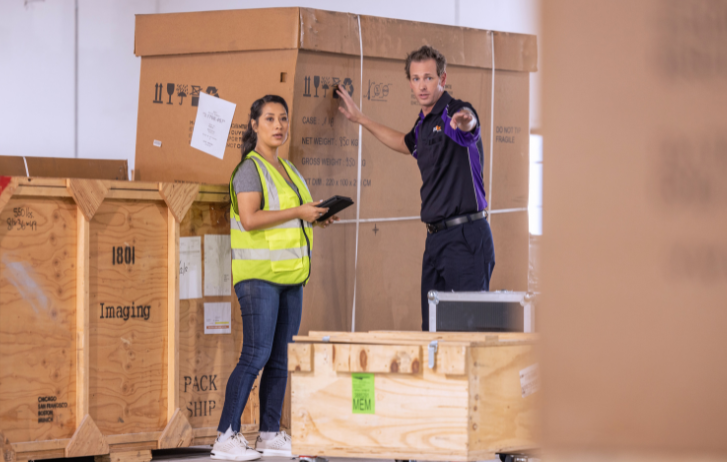
Import-Export 101: Your Guide To Starting An Import-Export Company
By FedEx | April 8, 2025
Ready to launch your own import and export company? Our step-by-step guide covers how to register a business, secure suppliers and buyers, and work with trusted logistics providers to simplify your operations.
- Behind every physical and digital storefront is a thriving import and export industry.
- A surge in activity in the intra-Asia and China-Southeast Asia trade corridors makes the Asia Pacific region a mecca for businesses looking for international trade opportunities.
- Import and export companies in Asia can leverage digital technologies and smart supply chain management to get new import-export businesses off to a flying start.
How do your favorite Japanese matcha powder or Korean skincare products make their way to stores around the world? Behind these popular consumer products is a thriving import-export industry that connects businesses with customers worldwide.
If you’re a supplier, manufacturer, or a business that buys and sells products, you may have considered starting an import-export company to streamline your business. Here, we break down exactly what it takes to import and export on the global stage.
Why start an import and export company?
The import-export industry has evolved dramatically in recent years. Digital platforms, improved logistics, and growing e-commerce demand have made it easier for companies of all sizes to get into the import-export game.
Despite a volatile global landscape fraught with trade tensions, Asia Pacific’s rapid economic growth offers huge potential for businesses. In 2023, Asia Pacific’s import and export activities accounted for nearly 40% of global trade activities, totaling about US$18 trillion.
Despite supply chain challenges posed by geopolitical tensions and the climate crisis, opportunities are emerging within intra-Asia trade corridors. This makes Asia Pacific a prime location for businesses seeking international trade opportunities.
Starting an import and export company allows you to unlock the region’s potential, tapping into new customer bases and diversifying your revenue streams. You can also leverage global trade trends, such as sustainable products or specialty foods.
You don’t need to look far to find APAC businesses that have found success through imports and exports. Take, for instance, Japan’s homegrown stationery brands. They’re currently riding high on the rising export value of writing instruments, especially with the world’s growing fascination with their unique designs.
Being an importer or an exporter: What’s the difference?
While imports and exports go hand in hand, they don’t function the same way.
Importers bring goods into their country to sell domestically. They source products overseas and manage customs duties. On the other hand, exporters sell products to foreign buyers. They handle shipping, documentation, and local regulations.
Some import and export companies do both, managing international sales and sourcing simultaneously. It’s up to you to choose where to focus your time and resources based on your company’s niche.
Import and export 101: A guide for SMEs
Launching your own import and export company might seem daunting at first. After all, there are many moving parts to juggle, including managing suppliers and buyers.
But there are ways to streamline processes and unlock greater efficiency. Here’s a step-by-step guide to get you started.
1. Choose your niche
First, pinpoint the products you intend to trade. Most importers and exporters get started because they have spotted a trend or opportunity with consumer demand behind it.
Start by researching goods and markets, identifying suppliers or buyers in APAC or other key regions. Use resources like trade association websites, government export data, and e-commerce trends to assess what’s in demand.
Inspiration and growing trends can be found by checking out the world’s top imports and exports. For example, China, the world’s leading exporter, counts electronics, furniture, and textiles among its most exported products. The United States, the world’s largest importer of goods, receives large volumes of industrial supplies, automobiles, medicines, and electronics annually.
2. Register your business
Make it official by registering your import and export company. This may include obtaining an import-export license, registering for Goods and Services Tax (GST), and ensuring your business name complies with legal requirements.
In Singapore, for instance, businesses must obtain necessary permits through the TradeNet system managed by Singapore Customs.
There’s plenty of paperwork required to get your import-export company up and running. Get it sorted right at the start to avoid penalties, delays, or unforeseen costs. Keep an eye on government websites to stay updated on the latest policy and process changes related to import and export businesses.
3. Secure suppliers and buyers
Today, supply chain disruptions are on the rise. The best way to strengthen your import and export strategy is to create a diverse pool of suppliers and buyers you can trust.
On the supplier side, research potential vendors carefully to ensure product quality and reliability. In the past, retailers attended regional trade fairs and met suppliers face-to-face to expand their supply chains. Today, platforms such as Alibaba have made it easier for importers and exporters to find verified suppliers and buyers.
When evaluating suppliers:
- Request product samples to check quality and negotiate for clear payment terms.
- Do a thorough due diligence check to verify the supplier’s credentials.
- Conduct an on-site visit to assess product quality and production output firsthand.
Similarly, vet your potential buyers to ensure they are legitimate businesses with the financial stability to fulfill their purchase commitments.
4. Arrange your logistics and shipping
Without efficient logistics, your import and export company will literally go nowhere. What’s the point of having a solid roster of suppliers and buyers if you can’t ship out or receive goods on time?
If you’re just starting out, work with a trusted logistics provider to ensure fast and reliable delivery. One benefit of working with logistics providers is the ability to leverage their existing tools and systems.
For example, solutions like FedEx Ship Manager can help simplify your shipments – whether they’re inbound, outbound, or return shipments. A handy feature for importers is the Collaborative Shipping Tool, which enables you to conveniently schedule pickups online with just a few clicks, offering more visibility between sender and receiver.
5. Understand customs and compliance
Each country has different regulations for importing and exporting. You’ll need to understand both the export regulations of the country you’re buying from and the import rules of the market you’re bringing goods into. As a starting point, do your homework on rules related to:
- Product labeling requirements
- Import taxes and duties
- Restricted or prohibited items
- Documentation such as commercial invoices, packing lists, and certificates of origin
In today’s volatile global trade landscape, rules can change at short notice. Proactively check government websites and trade publications to get the latest regulatory updates.
With regulations, paperwork, and even new tariffs to keep up with, having an import and export company might seem like an administrative headache. However, you can now leverage smart digital tools to simplify the process.
For example, our recently launched FedEx Import Tool helps you manage the clearance of your import shipments. This automated solution makes it easy for you to submit or download clearance-related documents, while providing visibility into the clearance status of your imports and notifying you of any incomplete clearance tasks.
Ready to build your import and export empire?
Whether you’re planning to import specialty foods from Thailand or export consumer electronics to Europe, FedEx can support your logistics journey every step of the way. We offer a range of solutions to help import and export companies stay efficient and competitive in the global marketplace.
For more tips, check out our dedicated imports guide here.
SHARE THIS STORY
- How To Ship A Giant Panda
- How To Make Freight Shipments Work For Your Small Business
- The Rise Of Intra-Asia Trade: Opportunities In The China-Southeast Asia Corridor
- Southeast Asia: The Next Manufacturing Powerhouse?
- 8 Most Unusual Shipments In The History Of FedEx
- Where Do Old Planes Go When They Retire?
Sign up now and save on your shipping rates!
Sign up now and earn discounts by shipping instantly with FedEx Ship ManagerTM at fedex.com.
Recommended For You

5 Common Logistics Challenges And How To Tackle Them
Is your business running into obstacles when shipping internationally? Get tips to resolve common logistics challenges for importers in Asia Pacific.
Read More
The Rise Of Intra-Asia Trade: Opportunities In The China-Southeast Asia Corridor
Emerging trade lanes in Asia present possibilities for businesses of all sizes, particularly APAC SMEs looking for international trade opportunities.
Read More
How To Get Your Import Strategy Up To Speed
From customs tariffs and regulations to suppliers and import management tools, check out our guide to smoother cross-border imports.
Read More



